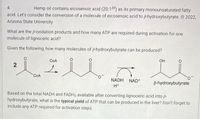
Human Anatomy & Physiology (11th Edition)
11th Edition
ISBN: 9780134580999
Author: Elaine N. Marieb, Katja N. Hoehn
Publisher: PEARSON
expand_more
expand_more
format_list_bulleted
Question

Transcribed Image Text:Hemp oil contains eicosenoic acid (20:149) as its primary monounsaturated fatty
acid. Let's consider the conversion of a molecule of eicosenoic acid to B-hydroxybutyrate. 2022,
4.
Arizona State University
What are the f-oxidation products and how many ATP are required during activation for one
molecule of lignoceric acid?
Given the following, how many molecules of 6-hydroxybutyrate can be produced?
COA
OH
COA
NADH
NAD+
B-hydroxybutyrate
H*
Based on the total NADH and FADH, available after converting lignoceric acid into ß
hydroxybutyrate, what is the typical yield of ATP that can be produced in the liver? Don't forget to
include any ATP required for activation steps.
Expert Solution
This question has been solved!
Explore an expertly crafted, step-by-step solution for a thorough understanding of key concepts.
Step by stepSolved in 2 steps

Knowledge Booster
Learn more about
Need a deep-dive on the concept behind this application? Look no further. Learn more about this topic, biology and related others by exploring similar questions and additional content below.Similar questions
- During the process of synthesizing palmitate (C16), an acyl ACP __________. For the sake of this question, don’t treat acetyl ACP or malonyl ACP as an acyl ACP; assume the acyl ACP is a product at least 4 carbons long. Choose ALL that apply. (A) can be condensed with malonyl ACP to produce a Cn+2 b-ketoacyl ACP (B) is formed from the reduction of a trans D2-enoyl ACP(C) is a product of acetyl transacylase(D) is reduced by NADPH (E) is a substrate for b-ketoacyl synthase(F) can be condensed with acetyl ACP to produce a Cn+2 b-ketoacyl ACParrow_forwardFatty acid beta-oxidation consists of 4 steps that are repeated multiple times. Explain the purpose of step 2 and step 3 respectively. (You don’t need to provide names of enzymes or intermediates!).arrow_forwardWhich reaction in the citric acid cycle is most analogous to the oxidative decarboxylation of 6- phosphogluconate to ribulose 5-phosphate? What kind of enzymebound intermediate is formed in both reactions?arrow_forward
- What product will accumulate if the there is a degradation defect involving the given amino acids? Choices: ?-ketoisovalerate ?-keto-β-methylvalerate ?-ketoisocaproate Phenylpyruvate 4-hydroxyphenylpyruvate dioxygenase Isoleucine Phenylalanine Leucine Valine Tyrosine Amino Acid Degradation Pathway (some choices can be selected more than once) Choices: Phenylalanine Tyrosine Cystine Cysteine Branched-Chain Amino Acids Aromatic Amino Acids Richner-Hanhart Syndrome Tyrosinemia Type III Cystinuria Maple-Syrup Urine Disease Tyrosinemia Type 1 Phenylketonuria Black-Urine Disease Management (some choices may be selected more than once). The number after the condition represents the number of answers required for that item. Choices: Sapropterin Pegvaliase Methionine restriction Vitamin A derivatives Emollients Nitisinone No treatment yet Vitamin B1 Vitamin C Acetazolamide, Hyperdiuresis L-CDME Phenylketonuria (2) Cystinuria (3) Black Urine Disease (2)…arrow_forwardDuring glycogen synthesis, glucose-1P is converted into a molecule called UDPG. This reaction also cleaves uridine triphosphate (UTP) forming uridine monophosphate and pyrophosphate (PPi). Provide four reasons why UTP can be used to power this reaction (no diagrams necessary).arrow_forwardWrite an overall reaction for β-oxidation of a 22:0 fatty acid.arrow_forward
- Describe how a) Mean Arterial Pressure, b) Maximal Oxygen Consumption, and c) Blood Flow are determined using its formula. In addition, you should explain what those factors are including cardiac output, stroke volume, heart rate, resistance, a-vO2 difference, etc. Describe how many ATPs can be generated by complete cycles of beta oxidation of free fatty acid with 20 carbons. You should indicate how many cycles of beta oxidation and Krebs cycle, and total number of products as wellarrow_forwardwhich statements are false?arrow_forwardAnswer A,B,Carrow_forward
- Can u help me to explain to me, please? I stuggled my homework and i need help to understand itarrow_forwardWater production from fatty acid oxidation is a survival mechanism in animals where water is scarce. Cells oxidize palmitoyl-CoA to produce water. If an animal has 5.000 kg of palmitoyl-CoA available for fatty acid oxidation, how many kilograms of water could the animal produce from that palmitoyl-CoA? The chemical formula for palmitoyl-CoA is C37H66N7O17P3S.arrow_forward54. 2,3-Bisphosphoglycerate: (MARK ALL THAT APPLY) Group of answer choices is absorbed from food binds in the central cavity in the T-form of hemoglobin. is released by the liver into the bloodstream cannot bind in the presence of oxygen preferentially binds to oxygen-bound hemoglobin and stabilizes it.arrow_forward
arrow_back_ios
SEE MORE QUESTIONS
arrow_forward_ios
Recommended textbooks for you
 Human Anatomy & Physiology (11th Edition)BiologyISBN:9780134580999Author:Elaine N. Marieb, Katja N. HoehnPublisher:PEARSON
Human Anatomy & Physiology (11th Edition)BiologyISBN:9780134580999Author:Elaine N. Marieb, Katja N. HoehnPublisher:PEARSON Biology 2eBiologyISBN:9781947172517Author:Matthew Douglas, Jung Choi, Mary Ann ClarkPublisher:OpenStax
Biology 2eBiologyISBN:9781947172517Author:Matthew Douglas, Jung Choi, Mary Ann ClarkPublisher:OpenStax Anatomy & PhysiologyBiologyISBN:9781259398629Author:McKinley, Michael P., O'loughlin, Valerie Dean, Bidle, Theresa StouterPublisher:Mcgraw Hill Education,
Anatomy & PhysiologyBiologyISBN:9781259398629Author:McKinley, Michael P., O'loughlin, Valerie Dean, Bidle, Theresa StouterPublisher:Mcgraw Hill Education, Molecular Biology of the Cell (Sixth Edition)BiologyISBN:9780815344322Author:Bruce Alberts, Alexander D. Johnson, Julian Lewis, David Morgan, Martin Raff, Keith Roberts, Peter WalterPublisher:W. W. Norton & Company
Molecular Biology of the Cell (Sixth Edition)BiologyISBN:9780815344322Author:Bruce Alberts, Alexander D. Johnson, Julian Lewis, David Morgan, Martin Raff, Keith Roberts, Peter WalterPublisher:W. W. Norton & Company Laboratory Manual For Human Anatomy & PhysiologyBiologyISBN:9781260159363Author:Martin, Terry R., Prentice-craver, CynthiaPublisher:McGraw-Hill Publishing Co.
Laboratory Manual For Human Anatomy & PhysiologyBiologyISBN:9781260159363Author:Martin, Terry R., Prentice-craver, CynthiaPublisher:McGraw-Hill Publishing Co. Inquiry Into Life (16th Edition)BiologyISBN:9781260231700Author:Sylvia S. Mader, Michael WindelspechtPublisher:McGraw Hill Education
Inquiry Into Life (16th Edition)BiologyISBN:9781260231700Author:Sylvia S. Mader, Michael WindelspechtPublisher:McGraw Hill Education

Human Anatomy & Physiology (11th Edition)
Biology
ISBN:9780134580999
Author:Elaine N. Marieb, Katja N. Hoehn
Publisher:PEARSON

Biology 2e
Biology
ISBN:9781947172517
Author:Matthew Douglas, Jung Choi, Mary Ann Clark
Publisher:OpenStax

Anatomy & Physiology
Biology
ISBN:9781259398629
Author:McKinley, Michael P., O'loughlin, Valerie Dean, Bidle, Theresa Stouter
Publisher:Mcgraw Hill Education,

Molecular Biology of the Cell (Sixth Edition)
Biology
ISBN:9780815344322
Author:Bruce Alberts, Alexander D. Johnson, Julian Lewis, David Morgan, Martin Raff, Keith Roberts, Peter Walter
Publisher:W. W. Norton & Company

Laboratory Manual For Human Anatomy & Physiology
Biology
ISBN:9781260159363
Author:Martin, Terry R., Prentice-craver, Cynthia
Publisher:McGraw-Hill Publishing Co.

Inquiry Into Life (16th Edition)
Biology
ISBN:9781260231700
Author:Sylvia S. Mader, Michael Windelspecht
Publisher:McGraw Hill Education